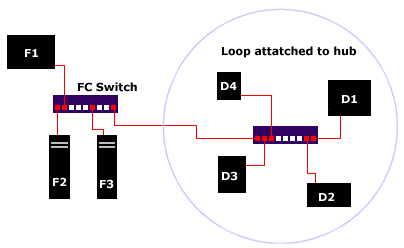|
Fibre
Channel : Switched Fabric
Fibre
Channel (Fibre Channel) architecture offers three topologies
for network design: point-to-point, Arbitrated Loop, and
Switched Fabric. All are based on high throughput speeds,
with effective 100MB per second throughput in half-duplex
mode and up to 200 megabyte in full duplex mode.
A
Fibre Channel hub can also participate within a switched
environment in the same manner that an Ethernet switch
can be utilised to segment a network. Fibre Channel Switches
are very similar in operation to their networking cousins,
offering both dedicated bandwidth to a single Fibre Channel
device at either 100MB or 200MB in full duplex mode, or
offering switched bandwidth to a hub that in turn offers
each device a share of the bandwidth available via standard
contention.

In
the example above F1, F2, and F3 have a dedicated connection
from the switch and can operate effectively at 100MB per
second. The loop operates independently however, with
all devices effectively sharing the bandwidth. This means
that devices in the loop (D1-D4) have to compete with
each other for bandwidth.
If
all devices were active simultaneously the bandwidth available
to each device would be slightly less than 25MB per second.
If a singe device was active whilst the other three were
inactive, the active device would be able to utilise the
entire 10MB maximum bandwidth. Devices connected directly
to the switch have the full 100MB bandwidth available
to them at all times.
In
the above example, all devices from F1 to D4 can all still
interoperate and communicate with each other. Dividing
the network into smaller segments by using a combination
of switches and hubs can improve performance and administration.
|